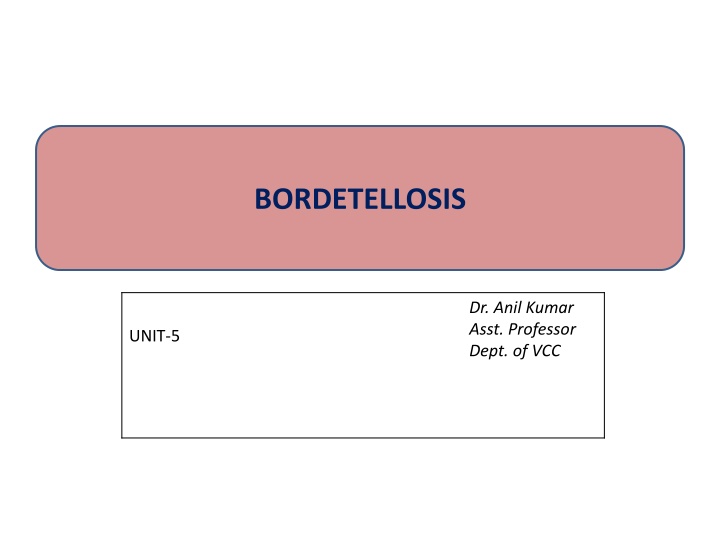BORDETELLOSIS
Bordetellosis is discussed by Dr. Anil Kumar, an Assistant Professor in the VCC department. Explore detailed insights into this topic in UNIT-5 of the course. Gain valuable knowledge and information regarding this aspect of veterinary science.
Download Presentation

Please find below an Image/Link to download the presentation.
The content on the website is provided AS IS for your information and personal use only. It may not be sold, licensed, or shared on other websites without obtaining consent from the author.If you encounter any issues during the download, it is possible that the publisher has removed the file from their server.
You are allowed to download the files provided on this website for personal or commercial use, subject to the condition that they are used lawfully. All files are the property of their respective owners.
The content on the website is provided AS IS for your information and personal use only. It may not be sold, licensed, or shared on other websites without obtaining consent from the author.
E N D
Presentation Transcript
BORDETELLOSIS Dr. Anil Kumar Asst. Professor Dept. of VCC UNIT-5
BORDETELLOSIS Bordetella (also referred to as tracheobronchitis, canine cough [in dogs], and feline bordetellosis [in cats]) is a highly contagious respiratory disease in cats and dogs/ It is caused by the bronchiseptica. It causes inflammation of the trachea and bronchi. Transmission: Direct contact (licking, nuzzling) Through the air (coughing or sneezing), or via contaminated fomites. Transmission can occur between dogs and cats. bacteria Bordetella
Clinical Signs: Dry, hacking cough (dogs) Retching Sneezing Watery nasal discharge Pneumonia, inappetence, fever, and lethargy in severe case Risk Factors: Pets that come from shelters, rescue centers, breeding kennels, or pet stores Boarding at a kennel Pets that participate in events/competitions Multiple pet homes
Treatment: Cough derivatives, such as hydrocodone (0.25 mg/kg, PO, bid-qid) or butorphanol (0.05 0.1 mg/kg, PO or SC, bid-qid). Antibiotics are usually not needed except in severe chronic cases; quinolones, chloramphenicol, and tetracycline are preferable because they reach effective concentrations in the tracheobronchial mucosa. The antibiotic should be selected by culture and sensitivity tests of specimens collected by transtracheal aspiration or bronchoscopy. suppressants containing codeine cephalosporins,
Aerosolization treatment should be preceded by administration of bronchodilators. Endotracheal injection of antibiotics (eg, gentamicin) is a possible alternative to aerosolization. Corticosteroids may help alleviate clinical signs but should be used concurrently with an antibacterial agent; they are contraindicated in severely ill, coughing dogs. Antibiotics given PO or IM may not significantly reduce the numbers of B. bronchiseptica in the distal trachea or major bronchi. Thus, in severely affected dogs that are not responsive to parenteral antibiotics, kanamycin sulfate (250 mg) or gentamicin sulfate (50 mg) diluted in 3 mL of saline may be administered by aerosolization bid for 3 days
Prevention: Immunized with modified-live virus vaccines against distemper, parainfluenza, and CAV-2, which also provides protection against CAV-1. Commercial products frequently combine these agents and may include modified-live parvovirus and leptospiral antigens. An initial vaccination should be given at 6 8 wk and repeated twice at 3- to 4-wk intervals until the dog is 14 16 wk old. Revaccination should be performed annually. When the risk of B bronchiseptica infection is significant, a live, avirulent, intranasal vaccine or parenteral products containing subunit bacterial extracts should be used. A combination of an avirulent B. bronchiseptica and a modified- live parainfluenza vaccine is available for intranasal use. One inoculation is administered to puppies >3 wk old.

